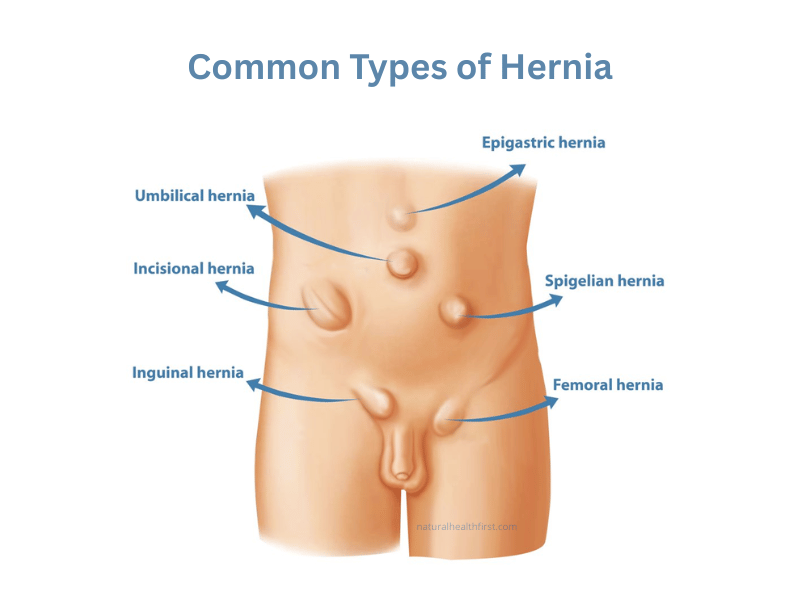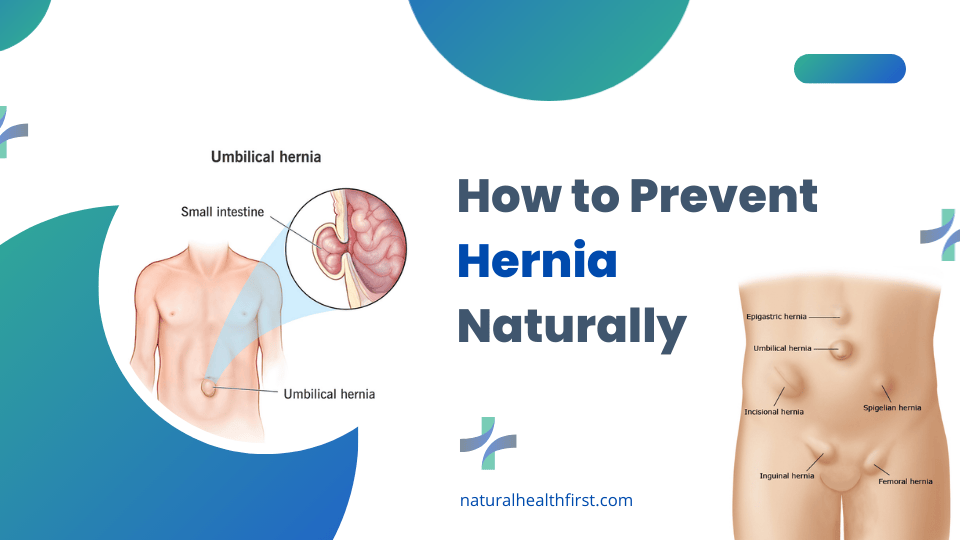As a naturopathic practitioner who has worked with countless patients dealing with hernia concerns, I’ve witnessed firsthand how natural prevention methods can dramatically reduce hernia risk and improve overall abdominal health. Over my twenty-year practice, I’ve developed comprehensive strategies that address the root causes of hernia formation rather than simply managing symptoms after they appear.
Hernias occur when internal organs or tissues push through weakened areas in the abdominal wall or other supporting structures. While genetics play a role, most hernias develop due to preventable factors like poor posture, weak core muscles, improper lifting techniques, chronic constipation, and lifestyle choices that increase intra-abdominal pressure.
The encouraging truth is that natural prevention methods are highly effective when applied consistently and comprehensively. By strengthening your body’s natural support systems, optimizing your digestive health, and adopting protective movement patterns, you can significantly reduce your hernia risk while improving your overall quality of life.
Let me share the evidence-based natural approaches I’ve refined through years of clinical practice and research.
Hernia Formation and Natural Prevention Principles
How to prevent hernia naturally begins with understanding why hernias develop and how natural interventions can address these underlying causes. Hernias form when increased pressure inside the abdomen meets weakened tissue or muscle walls, creating a pathway for organs or tissues to protrude.
The Natural Prevention Philosophy
Whole-body approach forms the foundation of effective hernia prevention. Rather than focusing solely on abdominal strength, natural prevention addresses multiple systems that contribute to hernia risk:
- Digestive health optimization reduces chronic pressure buildup
- Postural alignment minimizes stress on abdominal structures
- Movement quality protects against injury during daily activities
- Nutritional support strengthens connective tissues and reduces inflammation
- Stress management prevents chronic muscle tension and poor breathing patterns
Root cause addressing distinguishes natural prevention from conventional approaches. Instead of waiting for problems to develop, we strengthen the body’s inherent protective mechanisms and eliminate contributing factors before they create vulnerabilities.
Common Hernia Risk Factors We Can Address Naturally
Modifiable risk factors that respond well to natural interventions include:
- Chronic cough or respiratory issues
- Constipation and straining during bowel movements
- Poor posture leading to muscle imbalances
- Weak core musculature from sedentary lifestyle
- Improper breathing patterns that increase abdominal pressure
- Inflammatory dietary patterns that weaken tissues
- Chronic stress creating muscle tension and poor movement patterns
Prevention timing is crucial for effectiveness. The earlier we address these factors, the more successful our prevention efforts become. Even individuals with genetic predisposition can significantly reduce their risk through comprehensive natural approaches.

Ways to Prevent Hernia at Home: Practical Daily Strategies
Ways to prevent hernia at home encompass simple yet powerful practices that fit seamlessly into your daily routine. These interventions require no special equipment or expensive treatments—just consistency and proper technique.
Morning Routine for Hernia Prevention
Gentle abdominal activation upon waking prepares your core for daily activities:
Start each day with 5-10 minutes of deep breathing exercises while lying on your back. Place one hand on your chest and another on your abdomen. Focus on expanding your lower hand while keeping the upper hand relatively still. This activates your diaphragm and deep abdominal muscles naturally.
Posture check and alignment should become automatic:
Before rising from bed, spend a moment setting your postural awareness. Imagine a string pulling from the crown of your head, lengthening your spine. Engage your core gently—about 30% of maximum effort—and maintain this activation as you move through morning activities.
Evening Prevention Practices
Digestive support routine before sleep promotes healthy elimination:
Gentle abdominal massage using circular motions can stimulate digestion and prevent constipation. Start at your right lower abdomen and move clockwise, following the path of your large intestine. Spend 5-10 minutes on this practice while focusing on deep, relaxed breathing.
Stress release techniques prevent chronic tension buildup:
Progressive muscle relaxation specifically targeting abdominal and pelvic areas helps prevent the chronic tension that contributes to hernia formation. Tense and release each muscle group for 5 seconds, ending with your entire core region.
Throughout-the-Day Awareness
Breathing pattern monitoring prevents harmful pressure spikes:
Many people hold their breath during daily activities, creating dangerous pressure increases. Practice breathing continuously during tasks like lifting groceries, climbing stairs, or bending over. Exhale during the exertion phase of any activity.
Posture maintenance during sedentary activities protects abdominal integrity:
If you work at a desk, set hourly reminders to check your posture. Sit with your feet flat on the floor, shoulders back, and core gently engaged. Take brief walking breaks every 45-60 minutes to reset your positioning.
Best Exercises to Prevent Hernia: Building Natural Protection
Best exercises to prevent hernia focus on developing balanced strength, stability, and coordination throughout your core region. These exercises should feel challenging but never cause strain or breath-holding.
Foundation Movement Patterns
Deep breathing exercises form the cornerstone of hernia prevention:
Diaphragmatic breathing technique:
- Lie on your back with knees bent, feet flat on floor
- Place one hand on chest, one on abdomen
- Inhale slowly, expanding lower hand while upper hand stays still
- Exhale through pursed lips, gently drawing navel toward spine
- Practice for 10-15 breaths, 2-3 times daily
This exercise strengthens your deepest abdominal muscle (transverse abdominis) while improving respiratory function.
Pelvic floor engagement provides crucial foundational support:
Basic pelvic floor activation:
- Sit comfortably with spine neutral
- Visualize gently lifting the muscles between your pubic bone and tailbone
- Hold for 5 seconds while breathing normally
- Release slowly and completely
- Repeat 10-15 times, building endurance gradually
Progressive Strength Building
Modified plank progressions build functional core strength safely:
Wall plank (beginner level):
- Stand arm’s length from wall, hands flat against wall at shoulder height
- Engage core and hold straight line from head to heels
- Hold 15-30 seconds, building to 60 seconds
Incline plank (intermediate):
- Use sturdy surface like couch or bed for hands
- Maintain straight body line, core engaged
- Progress from 30 seconds to 90 seconds
Traditional plank (advanced):
- Only progress here after mastering previous levels
- Focus on quality over duration
- Never allow back to sag or hips to pike
Functional Movement Training
Safe lifting pattern practice prepares you for daily activities:
Squat lifting technique:
- Stand with feet hip-width apart, toes slightly out
- Engage core before movement begins
- Hinge at hips and knees, keeping chest proud
- Breathe out during lifting phase
- Practice with light objects before progressing
Rotational stability exercises protect against twisting injuries:
Dead bug exercise:
- Lie on back, arms reaching toward ceiling
- Knees bent at 90 degrees over hips
- Slowly lower opposite arm and leg toward floor
- Return to start position with control
- Alternate sides for 10-15 repetitions
How to Avoid Hernia During Lifting: Protective Techniques
How to avoid hernia during lifting requires mastering proper body mechanics and understanding your individual limits. Most lifting-related hernias occur due to poor technique rather than excessive weight.
Pre-Lifting Preparation
Body positioning assessment before any lifting task:
Always position yourself as close to the object as possible. Your feet should be shoulder-width apart with one foot slightly ahead of the other for stability. Check that your path is clear and plan your movement before beginning.
Core activation sequence creates internal stability:
Before touching the object, take a deep breath and gently engage your core muscles—imagine bracing for a light punch to the stomach. This creates internal pressure that supports your spine and abdominal wall during the lift.
Proper Lifting Mechanics
The hip hinge movement protects your back and abdomen:
Correct lifting sequence:
- Approach object with feet positioned properly
- Engage core and breathe normally
- Hinge at hips, keeping back straight
- Grip object firmly with both hands when possible
- Drive through heels to stand, object close to body
- Exhale during the lifting phase
- Reverse the movement to lower object
Weight distribution principles minimize abdominal pressure:
Keep lifted objects as close to your body as possible. The farther an object is from your center of gravity, the more stress it places on your abdominal muscles. When carrying objects, distribute weight evenly between both sides of your body.
Recognizing Your Limits
Progressive loading builds lifting capacity safely:
Start with lighter weights and perfect your technique before advancing. Your body should feel challenged but never strained. If you cannot maintain proper form throughout the entire lift, the weight is too heavy.
Warning sign recognition prevents injury:
Stop immediately if you experience:
- Breath holding or inability to breathe normally
- Sharp pain anywhere in your body
- Trembling or inability to control the movement
- Feeling of excessive pressure in your abdomen or chest
Preventing Inguinal Hernia Through Natural Methods
Preventing inguinal hernia requires specific attention to the groin area where the abdominal wall naturally has weaker points. These hernias account for about 80% of all abdominal wall hernias and respond well to targeted prevention strategies.
Understanding Inguinal Vulnerability
Anatomical weak points in the inguinal region create natural hernia risk:
The inguinal canal allows blood vessels and nerves to pass through the abdominal wall. In men, this canal also contains the spermatic cord, creating a larger potential space for herniation. Women have a smaller canal for the round ligament, but pregnancy and childbirth can weaken this area.
Risk factors specific to inguinal hernias include:
- Chronic cough or sneezing
- Heavy lifting with poor technique
- Chronic constipation causing straining
- Rapid weight gain stretching abdominal muscles
- Previous abdominal surgery creating scar tissue weakness
Targeted Prevention Strategies
Groin-specific strengthening addresses the unique needs of this region:
Adductor strengthening exercise:
- Lie on your side with bottom leg straight, top leg bent behind
- Lift bottom leg slowly while maintaining core engagement
- Hold for 2-3 seconds, lower with control
- Perform 10-15 repetitions each side
Hip flexor stretching prevents muscle imbalances:
Couch stretch modification:
- Place back foot on couch or bed, front foot on ground
- Gently lean forward into stretch, feeling front of hip
- Hold 30-60 seconds each side
- Focus on maintaining neutral spine throughout
Lifestyle Modifications for Inguinal Health
Cough and sneeze technique protects against pressure spikes:
When you feel a cough or sneeze coming, quickly place one hand on your lower abdomen and gently support the area while turning your head away from others. This reduces the sudden pressure increase that can contribute to hernia formation.
Constipation prevention eliminates a major risk factor:
Maintain regular bowel movements through adequate fiber intake, proper hydration, and regular physical activity. Straining during bowel movements creates significant pressure in the inguinal region.
How to Strengthen Abdominal Muscles to Prevent Hernia
How to strengthen abdominal muscles to prevent hernia involves targeting all layers of your core system, not just the visible “six-pack” muscles. Effective hernia prevention requires deep muscle strength and endurance.
Understanding Your Core System
Four key muscle groups work together for optimal core function:
Diaphragm (top of core):
- Primary breathing muscle
- Creates pressure changes during respiration
- Must coordinate with other core muscles
Pelvic floor (bottom of core):
- Supports pelvic organs
- Provides foundational stability
- Often weakened by childbirth, surgery, or aging
Transverse abdominis (deepest abdominal muscle):
- Acts like a natural corset
- Provides spinal stability
- Often inhibited by poor posture or breathing patterns
Multifidus (deep back muscles):
- Provides segmental spinal stability
- Works with transverse abdominis
- Critical for proper lifting mechanics
Progressive Strengthening Protocol
Phase 1: Foundation Building (Weeks 1-4)
Deep abdominal activation:
- Lie on back with knees bent
- Place fingertips just inside hip bones
- Gently draw navel toward spine (30% effort)
- Hold 10 seconds while breathing normally
- Relax completely between repetitions
Phase 2: Stability Integration (Weeks 5-8)
Dead bug progression:
- Master basic position with arms and legs still
- Add slow arm movements while maintaining core stability
- Progress to leg movements
- Advance to opposite arm and leg movements
Phase 3: Functional Strength (Weeks 9-12)
Modified plank progressions:
- Begin with wall plank, progress to incline
- Add arm or leg movements once basic position is mastered
- Increase hold times gradually
- Focus on quality over duration
Advanced Strengthening Strategies
Breathing coordination during exercises maximizes effectiveness:
Never hold your breath during core exercises. Practice coordinating your breathing with movement—typically exhaling during the effort phase and inhaling during the return phase.
Progressive overload principles ensure continued improvement:
Increase difficulty through:
- Longer hold times
- More challenging positions
- Added instability (like closing eyes)
- Increased repetitions
- Combination movements
Dietary Changes to Prevent Hernia: Nutritional Support
Dietary changes to prevent hernia focus on reducing inflammation, supporting tissue health, and preventing conditions like constipation that increase hernia risk.
Anti-Inflammatory Nutrition Foundation
Foods that help prevent hernia by reducing systemic inflammation:
Omega-3 rich foods:
- Wild-caught fatty fish (salmon, mackerel, sardines)
- Walnuts and flaxseeds
- Chia seeds and hemp hearts
- Grass-fed beef and pasture-raised eggs
Antioxidant-dense vegetables:
- Dark leafy greens (kale, spinach, arugula)
- Colorful bell peppers
- Cruciferous vegetables (broccoli, cauliflower, Brussels sprouts)
- Purple vegetables (red cabbage, purple onions, eggplant)
Polyphenol-rich fruits:
- Berries of all varieties
- Cherries and pomegranates
- Green tea and herbal teas
- Dark chocolate (85% cacao or higher)
Digestive Health Optimization
Fiber-rich foods prevent constipation and reduce straining:
Soluble fiber sources:
- Oats and barley
- Beans and lentils
- Apples and pears with skin
- Psyllium husk supplement if needed
Insoluble fiber sources:
- Whole grains and brown rice
- Nuts and seeds
- Vegetables like carrots and celery
- Fruits with edible seeds
Hydration strategies support healthy elimination:
Drink half your body weight in ounces of water daily. Start each day with 16-20 ounces of warm water with lemon to stimulate digestive function. Herbal teas like ginger, fennel, and peppermint can support digestive health while contributing to hydration.
Foods to Minimize or Avoid
Inflammatory foods that may weaken connective tissues:
- Processed foods with artificial additives
- Refined sugars and high-fructose corn syrup
- Trans fats and heavily processed oils
- Excessive alcohol consumption
Constipation-promoting foods:
- Low-fiber processed foods
- Excessive dairy products (if sensitive)
- Red meat without adequate fiber intake
- Refined grains and white flour products

Prevent a Hernia in Pregnancy: Special Considerations
Prevent a hernia in pregnancy requires modified approaches that account for the unique physiological changes and safety considerations during this time.
Understanding Pregnancy-Related Hernia Risk
Physiological changes that increase hernia vulnerability:
Hormonal influences:
- Relaxin hormone softens connective tissues
- Progesterone slows digestive function
- Estrogen affects collagen synthesis
Physical changes:
- Growing uterus stretches abdominal muscles
- Increased intra-abdominal pressure
- Postural changes affecting muscle balance
- Weight gain stressing abdominal wall
Safe Prevention Strategies During Pregnancy
Modified exercise approaches for each trimester:
First trimester: Continue regular exercise with attention to form Second trimester: Avoid supine positions after 20 weeks, focus on side-lying and seated exercises Third trimester: Emphasize breathing exercises, gentle stretching, and supported positions
Pregnancy-safe core exercises:
Standing pelvic tilts:
- Stand with back against wall
- Gently tilt pelvis to flatten lower back against wall
- Hold 5 seconds, repeat 10-15 times
- Coordinate with breathing
Modified cat-cow on hands and knees:
- Start in tabletop position
- Gently arch and round spine
- Coordinate movement with breathing
- Focus on mobility rather than strength
Postpartum Hernia Prevention
Diastasis recti management prevents umbilical hernia risk:
Check for abdominal separation 6-8 weeks postpartum. If separation is wider than 2 finger widths, focus on deep core rehabilitation before advancing to traditional abdominal exercises.
Gradual return to activity prevents injury:
Start with breathing exercises and gentle walking. Progress slowly to more challenging activities only after clearance from healthcare providers and establishment of good core control.
Hernia Prevention Tips for Seniors: Age-Appropriate Strategies
Hernia prevention tips for seniors must account for age-related changes in muscle mass, bone density, and healing capacity while remaining safe and effective.
Age-Related Risk Factors
Physiological changes that increase senior hernia risk:
Muscle mass decline (sarcopenia):
- Loss of 3-8% muscle mass per decade after age 30
- Accelerated loss after age 60
- Particular vulnerability in core muscles
Connective tissue changes:
- Decreased collagen production
- Reduced tissue elasticity
- Slower healing and recovery
Common health conditions affecting seniors:
- Chronic constipation
- Prostate enlargement causing straining
- Chronic cough from respiratory conditions
- Medications affecting digestion or muscle function
Senior-Safe Exercise Modifications
Chair-based core strengthening for those with mobility limitations:
Seated marching:
- Sit tall in sturdy chair
- Engage core gently
- Lift one knee slightly while breathing normally
- Lower with control, alternate legs
- Perform 10-15 repetitions each side
Wall-supported exercises provide stability:
Wall push-offs:
- Stand arm’s length from wall
- Place palms flat against wall at shoulder height
- Engage core and push away from wall
- Return to start position with control
- Perform 10-15 repetitions
Lifestyle Adaptations for Seniors
Home safety modifications prevent strain and injury:
- Use proper lifting aids like grabbers for high shelves
- Install grab bars in bathrooms
- Keep frequently used items at waist level
- Use wheeled carts instead of carrying heavy loads
Medication review with healthcare providers:
Some medications can affect digestion, muscle function, or balance. Regular medication reviews can identify drugs that might increase hernia risk and explore alternatives when appropriate.
How to Prevent Hiatus Hernia: Digestive Health Focus
How to prevent hiatus hernia centers on maintaining healthy digestive function and reducing factors that increase pressure on the diaphragm.
Understanding Hiatus Hernia Development
Anatomical considerations unique to hiatus hernias:
The hiatus is an opening in the diaphragm that allows the esophagus to pass through to the stomach. When the tissues around this opening weaken, part of the stomach can slide up into the chest cavity.
Contributing factors include:
- Increased abdominal pressure from obesity
- Chronic cough or vomiting
- Age-related tissue weakness
- Previous chest surgery or trauma
- Genetic predisposition to connective tissue weakness
Dietary Strategies for Prevention
Acid reflux management prevents tissue irritation:
Alkalizing foods:
- Leafy green vegetables
- Cucumber and celery
- Watermelon and cantaloupe
- Herbal teas (chamomile, ginger)
Meal timing and portion control:
- Eat smaller, more frequent meals
- Stop eating 3-4 hours before bedtime
- Chew food thoroughly and eat slowly
- Avoid lying down immediately after meals
Breathing and Posture Interventions
Diaphragmatic breathing strengthens the hiatal area:
Practice deep breathing exercises that emphasize diaphragm movement. This can help maintain strength and flexibility in the tissues around the hiatus.
Posture optimization reduces pressure on the diaphragm:
Maintain upright posture during and after meals. Sleep with your head elevated 6-8 inches to reduce nighttime acid reflux and pressure on the hiatal area.
Can Lifestyle Prevent Hernia: Comprehensive Prevention
Can lifestyle prevent hernia? Absolutely. Comprehensive lifestyle modifications address multiple risk factors simultaneously and provide the most effective long-term prevention strategy.
Daily Habits That Prevent Hernia Formation
Movement integration throughout your day:
Replace sedentary habits with movement opportunities. Take phone calls while walking, use a standing desk for portions of your workday, and incorporate stretching breaks every hour.
Stress management prevents chronic muscle tension:
Effective stress reduction techniques:
- Regular meditation or mindfulness practice
- Deep breathing exercises during stressful moments
- Regular physical activity you enjoy
- Adequate sleep (7-9 hours nightly)
- Social connection and support systems
Environmental Modifications
Workplace ergonomics support proper posture and movement:
Adjust your workspace to promote good posture. Your computer screen should be at eye level, feet flat on the floor, and back supported. Take regular breaks to stand and move.
Home organization minimizes unnecessary strain:
Store heavy items at waist level, use proper step stools for high items, and organize your space to minimize heavy lifting and awkward positions.
Hernia Prevention Belt: When and How to Use
Hernia prevention belt useful applications are limited but specific. Understanding when these devices help versus when they might create dependency is crucial.
Appropriate Belt Usage
Temporary support scenarios where belts may be beneficial:
- During recovery from abdominal surgery
- When returning to activity after injury
- During specific high-risk activities (heavy lifting at work)
- As a reminder to engage core muscles properly
Proper fitting and application:
A prevention belt should provide gentle compression without restricting breathing or movement. It should never be tight enough to cause discomfort or create indentations in your skin.
Limitations and Concerns
Dependency risks from overusing support devices:
Relying on external support can weaken your natural muscle function over time. Use belts as temporary aids while building strength, not as permanent solutions.
When to avoid belts:
- During exercise designed to strengthen core muscles
- All day, every day usage
- As a substitute for proper strengthening exercises
- When they cause discomfort or restrict normal movement
Prevent Hernia After Surgery: Recovery Considerations
Prevent hernia after surgery requires careful attention to healing tissues and gradual return to normal activity levels.
Post-Surgical Risk Factors
Incisional hernia development can occur at surgical sites:
Surgical incisions create temporary weak points in the abdominal wall. Poor healing, infection, or premature return to activity can lead to incisional hernias.
Timeline considerations for activity progression:
Most surgical incisions need 6-8 weeks for initial healing and 3-6 months for full strength recovery. Your surgeon’s specific guidelines should always take precedence over general recommendations.
Safe Recovery Strategies
Gradual activity progression:
Week 1-2 post-surgery:
- Focus on breathing exercises and gentle walking
- Avoid lifting anything heavier than 10 pounds
- Use log-rolling technique to get in and out of bed
Week 3-6 post-surgery:
- Add gentle stretching and range of motion exercises
- Gradually increase walking duration and pace
- Continue lifting restrictions as directed
Week 6+ post-surgery:
- Begin gentle core strengthening with healthcare provider approval
- Gradually return to normal activities
- Monitor incision sites for any changes or concerns
Creating Your Personal Hernia Prevention Plan
After two decades of helping patients prevent hernias naturally, I’ve learned that the most successful approaches are personalized, sustainable, and comprehensive. Your prevention plan should address your specific risk factors while fitting realistically into your lifestyle.
Assessment starting points for your personal plan:
- Current fitness level and movement quality
- Existing health conditions that might increase risk
- Occupational or recreational activities that create stress on your abdomen
- Family history and genetic predisposition
- Current symptoms or concerns
Implementation strategies for long-term success:
Start with one or two changes rather than attempting to overhaul your entire lifestyle immediately. Focus on building consistent habits before adding new elements to your prevention routine.
Progress monitoring helps maintain motivation:
Keep a simple journal tracking your exercise consistency, digestive health, energy levels, and any concerns. Regular check-ins with healthcare providers familiar with natural approaches can provide valuable feedback and adjustments.
Remember that hernia prevention is an investment in your long-term health and quality of life. The natural approaches I’ve outlined work synergistically to strengthen your body’s inherent protective mechanisms while addressing the underlying causes of hernia formation.
Consistency rather than perfection leads to the best outcomes. Small, daily actions compound over time to create significant improvements in your overall abdominal health and hernia risk reduction.
The human body has remarkable capacity for adaptation and healing when provided with the right conditions. By supporting your body’s natural strength and resilience through these evidence-based strategies, you can significantly reduce your hernia risk while improving your overall health and vitality.








